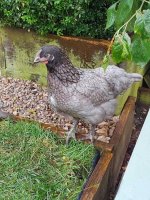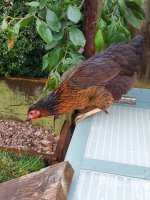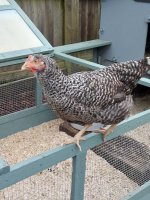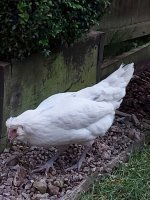Hi Joanne,
They are great to watch though it is usually them getting up to mischief and jumping up to eat your garden plants. We have mint in a tall pot and it has been shaved all round the sides!
I'm not sure that there is a definitive/right answer for either question but ...
Not saying that clipping wings is never necessary but you can quite easily put them off trying for the top of the fence. When they are stretching their necks up and waving their heads around they are trying to judge whether the object is safe to land on (and are very cautious over judging it right.). They would never go for landing on a washing line so my solution is to suspend a length of washing line just in front of the top of the fence. Clipped flight feathers do grow back but they look so good when they are intact.
RM I've studied in great detail! They are actually fascinating little creatures though they are a chickens worst nightmare so they have to go! This is just my opinion but there is so much commercial pushing of bad ideas out there that has little or negative effect - it drives me mad! Firstly, Mite powder is invariably based on diatomaceous earth whatever the brand. DE works against mites and lice by mechanically scratching away the protective waxy coat they have that prevents them drying out. It also acts as a sort of mop to soak up the lipids. It works particularly well on their leg joints (imagine walking a long way with sand inside the neck of your wellies!) The problem with DE is that the mite can react to it and become 'immune' and that happens when they are not quite killed and can still breed with tolerable amounts of it scattered around. Everyone scatters it everywhere like it is Shake'n'Vac, if it doesn't kill the RM within one generation (its not a chemical insecticide) then it pretty much makes them stronger.
I could ramble on for hours ... The answer is mite proof perches and DE can play a role in that but many coops dont physically lend themselves to its use. Grill type perches, for example, are impossible to protect.
You never dust the hens with it for RM - it will do nothing to protect them. DE can be used to discourage lice, because they live on the bird (a good top soil dust bath works just as well), but RM dont live on the bird, they live in the coop and walk to the chickens in the night to feed and then leave by the morning.
But you have a plastic coop and the benefit of them is you can strip it down easily to clean. What you really need is to know is if RM have moved in and know that as soon as possible. They dont always show up or, at least, it can be many years before they do but when they do you need to know immediately so you can strip the thing down and give it the thorough clean it is designed for. So you put an ideal RM house that is easy to inspect every time you are in there right next to the perches. A couple of pieces of clean plywood, one of them with elastic bands round each end and then the other on top is a perfect RM colony home and they wont be able to resist it. That way you know for sure when they are not around and can blitz them as soon as they are.
I hope that helps. RM are a really complex issue and the solution is as varied as the amount of different coops and set ups that are out there. I have found RM in our roost for the second time after a space of 3 years. Our roost is unusual because we dont have a coop They are open air perches in a covered and sheltered run) and, after re-doing the anti RM perches (I got a bit lackadaisical with keeping them up to spec when they had been wiped out last time but did know within a week when they re-appeared) they have disappeared again. It will be 9 months before I can drop the guard but the chickens are not getting bitten in the night, are having a restful sleep, and that is the important thing.




